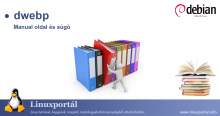Content
Data
license:
Version: 0.6.1 (in Debian 10)
Developer / owner:
Short description:
Manual page and help for the dwebp linux command. The dwebp command unpacks WebP files into PNG, PAM, PPM, or PGM files.
To use this command, you must install web package:
sudo apt-get install webp
Man page output
man dwebpDWEBP(1) General Commands Manual DWEBP(1)
NAME
dwebp - decompress a WebP file to an image file
SYNOPSIS
dwebp [options] input_file.webp
DESCRIPTION
This manual page documents the dwebp command.
dwebp decompresses WebP files into PNG, PAM, PPM or PGM images.
OPTIONS
The basic options are:
-h Print usage summary.
-version
Print the version number (as major.minor.revision) and exit.
-o string
Specify the name of the output file (as PNG format by default). Using "-" as output name
will direct output to 'stdout'.
-- string
Explicitly specify the input file. This option is useful if the input file starts with an
'-' for instance. This option must appear last. Any other options afterward will be ig‐
nored. If the input file is "-", the data will be read from stdin instead of a file.
-bmp Change the output format to uncompressed BMP.
-tiff Change the output format to uncompressed TIFF.
-pam Change the output format to PAM (retains alpha).
-ppm Change the output format to PPM (discards alpha).
-pgm Change the output format to PGM. The output consists of luma/chroma samples instead of
RGB, using the IMC4 layout. This option is mainly for verification and debugging pur‐
poses.
-yuv Change the output format to raw YUV. The output consists of luma/chroma-U/chroma-V sam‐
ples instead of RGB, saved sequentially as individual planes. This option is mainly for
verification and debugging purposes.
-nofancy
Don't use the fancy upscaler for YUV420. This may lead to jaggy edges (especially the red
ones), but should be faster.
-nofilter
Don't use the in-loop filtering process even if it is required by the bitstream. This may
produce visible blocks on the non-compliant output, but it will make the decoding faster.
-dither strength
Specify a dithering strength between 0 and 100. Dithering is a post-processing effect ap‐
plied to chroma components in lossy compression. It helps by smoothing gradients and
avoiding banding artifacts.
-alpha_dither
If the compressed file contains a transparency plane that was quantized during compres‐
sion, this flag will allow dithering the reconstructed plane in order to generate
smoother transparency gradients.
-nodither
Disable all dithering (default).
-mt Use multi-threading for decoding, if possible.
-crop x_position y_position width height
Crop the decoded picture to a rectangle with top-left corner at coordinates (x_position,
y_position) and size width x height. This cropping area must be fully contained within
the source rectangle. The top-left corner will be snapped to even coordinates if needed.
This option is meant to reduce the memory needed for cropping large images. Note: the
cropping is applied before any scaling.
-flip Flip decoded image vertically (can be useful for OpenGL textures for instance).
-resize, -scale width height
Rescale the decoded picture to dimension width x height. This option is mostly intended
to reducing the memory needed to decode large images, when only a small version is needed
(thumbnail, preview, etc.). Note: scaling is applied after cropping. If either (but not
both) of the width or height parameters is 0, the value will be calculated preserving the
aspect-ratio.
-quiet Do not print anything.
-v Print extra information (decoding time in particular).
-noasm Disable all assembly optimizations.
BUGS
Please report all bugs to the issue tracker: https://bugs.chromium.org/p/webp
Patches welcome! See this page to get started: http://www.webmproject.org/code/contribute/sub‐
mitting-patches/
EXAMPLES
dwebp picture.webp -o output.png
dwebp picture.webp -ppm -o output.ppm
dwebp -o output.ppm -- ---picture.webp
cat picture.webp | dwebp -o - -- - > output.ppm
AUTHORS
dwebp is a part of libwebp and was written by the WebP team.
The latest source tree is available at https://chromium.googlesource.com/webm/libwebp
This manual page was written by Pascal Massimino <pascal.massimino@gmail.com>, for the Debian
project (and may be used by others).
SEE ALSO
cwebp(1), gif2webp(1), webpmux(1)
Please refer to http://developers.google.com/speed/webp/ for additional information.
Output file format details
PAM: http://netpbm.sourceforge.net/doc/pam.html
PGM: http://netpbm.sourceforge.net/doc/pgm.html
PPM: http://netpbm.sourceforge.net/doc/ppm.html
PNG: http://www.libpng.org/pub/png/png-sitemap.html#info
June 23, 2016 DWEBP(1)
Help output
dwebp -hUsage: dwebp in_file [options] [-o out_file]
Decodes the WebP image file to PNG format [Default]
Use following options to convert into alternate image formats:
-pam ......... save the raw RGBA samples as a color PAM
-ppm ......... save the raw RGB samples as a color PPM
-bmp ......... save as uncompressed BMP format
-tiff ........ save as uncompressed TIFF format
-pgm ......... save the raw YUV samples as a grayscale PGM
file with IMC4 layout
-yuv ......... save the raw YUV samples in flat layout
Other options are:
-version ..... print version number and exit
-nofancy ..... don't use the fancy YUV420 upscaler
-nofilter .... disable in-loop filtering
-nodither .... disable dithering
-dither <d> .. dithering strength (in 0..100)
-alpha_dither use alpha-plane dithering if needed
-mt .......... use multi-threading
-crop <x> <y> <w> <h> ... crop output with the given rectangle
-resize <w> <h> ......... scale the output (*after* any cropping)
-flip ........ flip the output vertically
-alpha ....... only save the alpha plane
-incremental . use incremental decoding (useful for tests)
-h ........... this help message
-v ........... verbose (e.g. print encoding/decoding times)
-quiet ....... quiet mode, don't print anything
-noasm ....... disable all assembly optimizations
Related Content
- 28 views

